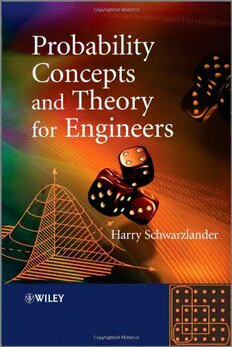Download Probability concepts and theory for engineers PDF Free - Full Version
Download Probability concepts and theory for engineers by Schwarzlander H. in PDF format completely FREE. No registration required, no payment needed. Get instant access to this valuable resource on PDFdrive.to!
About Probability concepts and theory for engineers
A thorough introduction to the fundamentals of probability theoryThis book offers a detailed explanation of the basic models and mathematical principles used in applying probability theory to practical problems. It gives the reader a solid foundation for formulating and solving many kinds of probability problems for deriving additional results that may be needed in order to address more challenging questions, as well as for proceeding with the study of a wide variety of more advanced topics.Great care is devoted to a clear and detailed development of the ‘conceptual model' which serves as the bridge between any real-world situation and its analysis by means of the mathematics of probability. Throughout the book, this conceptual model is not lost sight of. Random variables in one and several dimensions are treated in detail, including singular random variables, transformations, characteristic functions, and sequences. Also included are special topics not covered in many probability texts, such as fuzziness, entropy, spherically symmetric random variables, and copulas.Some special features of the book are:a unique step-by-step presentation organized into 86 topical Sections, which are grouped into six Parts over 200 diagrams augment and illustrate the text, which help speed the reader's comprehension of the material short answer review questions following each Section, with an answer table provided, strengthen the reader's detailed grasp of the material contained in the Section problems associated with each Section provide practice in applying the principles discussed, and in some cases extend the scope of that material an online separate solutions manual is available for course tutors. The various features of this textbook make it possible for engineering students to become well versed in the ‘machinery' of probability theory. They also make the book a useful resource for self-study by practicing engineers and researchers who need a more thorough grasp of particular topics.
Detailed Information
| Author: | Schwarzlander H. |
|---|---|
| Publication Year: | 2011 |
| ISBN: | 9780470748558 |
| Pages: | 623 |
| Language: | English |
| File Size: | 5.418 |
| Format: | |
| Price: | FREE |
Safe & Secure Download - No registration required
Why Choose PDFdrive for Your Free Probability concepts and theory for engineers Download?
- 100% Free: No hidden fees or subscriptions required for one book every day.
- No Registration: Immediate access is available without creating accounts for one book every day.
- Safe and Secure: Clean downloads without malware or viruses
- Multiple Formats: PDF, MOBI, Mpub,... optimized for all devices
- Educational Resource: Supporting knowledge sharing and learning
Frequently Asked Questions
Is it really free to download Probability concepts and theory for engineers PDF?
Yes, on https://PDFdrive.to you can download Probability concepts and theory for engineers by Schwarzlander H. completely free. We don't require any payment, subscription, or registration to access this PDF file. For 3 books every day.
How can I read Probability concepts and theory for engineers on my mobile device?
After downloading Probability concepts and theory for engineers PDF, you can open it with any PDF reader app on your phone or tablet. We recommend using Adobe Acrobat Reader, Apple Books, or Google Play Books for the best reading experience.
Is this the full version of Probability concepts and theory for engineers?
Yes, this is the complete PDF version of Probability concepts and theory for engineers by Schwarzlander H.. You will be able to read the entire content as in the printed version without missing any pages.
Is it legal to download Probability concepts and theory for engineers PDF for free?
https://PDFdrive.to provides links to free educational resources available online. We do not store any files on our servers. Please be aware of copyright laws in your country before downloading.
The materials shared are intended for research, educational, and personal use in accordance with fair use principles.

